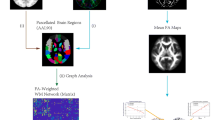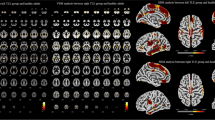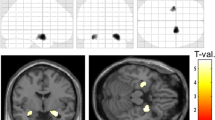Abstract
Background
Medial temporal lobe epilepsy (mTLE) has been associated with widespread white mater (WM) alternations in addition to mesial temporal sclerosis (MTS). Herein, we aimed to investigate the correlation between disease duration and WM structural abnormalities in mTLE using diffusion MRI (DMRI) connectometry approach.
Method
DMRI connectometry was conducted on 24 patients with mTLE. A multiple regression model was used to investigate white matter tracts with microstructural correlates to disease duration, controlling for age and sex. DMRI data were processed in the MNI space using q-space diffeomorphic reconstruction to obtain the spin distribution function (SDF). The SDF values were converted to quantitative anisotropy (QA) and used in further analyses.
Results
Connectometry analysis identified impaired white matter QA of the following fibers to be correlated with disease duration: bilateral retrosplenial cingulum, bilateral fornix, right inferior longitudinal fasciculus (ILF), and genu of corpus callosum (CC) (FDR = 0.009).
Conclusion
Our results were obtained from DMRI connectometry, which indicates the connectivity and the level of diffusion in nerve fibers rather just the direction of diffusion. Compared to previous studies investigating the correlation between duration of epilepsy and white matter integrity in mTLE patients, we detected broader and somewhat different associations in midline structures and component of limbic system. However, further studies with larger sample sizes are required to elucidate previous and current results.

Similar content being viewed by others
References
Engel J Jr (1996) Introduction to temporal lobe epilepsy. Epilepsy Res 26(1):141–150
Mameniskiene R, Rimsiene J, Puronaite R (2016) Cognitive changes in people with temporal lobe epilepsy over a 13-year period. Epilepsy Behav: E&B 63:89–97
Kwan P, Sperling MR (2009) Refractory seizures: try additional antiepileptic drugs (after two have failed) or go directly to early surgery evaluation? Epilepsia 50(Suppl 8):57–62
Lau T, Miller T, Klein T, Benbadis SR, Vale FL (2014) Temporal lobe surgery in medically refractory epilepsy: a comparison between populations based on MRI findings. Seizure 23(1):20–24
Jardim AP, Neves RS, Caboclo LO, Lancellotti CL, Marinho MM, Centeno RS, Cavalheiro EA, Scorza CA, Yacubian EM (2012) Temporal lobe epilepsy with mesial temporal sclerosis: hippocampal neuronal loss as a predictor of surgical outcome. Arq Neuropsiquiatr 70(5):319–324
Di Gennaro G, D'Aniello A, De Risi M, Grillea G, Quarato PP, Mascia A, Grammaldo LG, Casciato S, Morace R, Esposito V, Picardi A (2015) Temporal pole abnormalities in temporal lobe epilepsy with hippocampal sclerosis: clinical significance and seizure outcome after surgery. Seizure 32:84–91
Pauli C, Thais ME, Claudino LS, Bicalho MA, Bastos AC, Guarnieri R, Nunes JC, Lin K, Linhares MN, Walz R (2012) Predictors of quality of life in patients with refractory mesial temporal lobe epilepsy. Epilepsy Behav: E&B 25(2):208–213
Coan AC, Campos BM, Yasuda CL, Kubota BY, Bergo FP, Guerreiro CA, Cendes F (2014) Frequent seizures are associated with a network of gray matter atrophy in temporal lobe epilepsy with or without hippocampal sclerosis. PLoS One 9(1):e85843
Helmstaedter C, May TW, von Lehe M, Pfaefflin M, Ebner A, Pannek HW, Elger CE, Stefan H, Schramm J (2014) Temporal lobe surgery in Germany from 1988 to 2008: diverse trends in etiological subgroups. Eur J Neurol 21(6):827–834
Barba C, Rheims S, Minotti L, Guenot M, Hoffmann D, Chabardes S, Isnard J, Kahane P, Ryvlin P (2016) Temporal plus epilepsy is a major determinant of temporal lobe surgery failures. Brain J Neurol 139(Pt 2):444–451
Amlerova J, Cavanna AE, Bradac O, Javurkova A, Raudenska J, Marusic P (2014) Emotion recognition and social cognition in temporal lobe epilepsy and the effect of epilepsy surgery. Epilepsy Behav : E&B 36:86–89
Garbelli R, Milesi G, Medici V, Villani F, Didato G, Deleo F, D'Incerti L, Morbin M, Mazzoleni G, Giovagnoli AR, Parente A, Zucca I, Mastropietro A, Spreafico R (2012) Blurring in patients with temporal lobe epilepsy: clinical, high-field imaging and ultrastructural study. Brain J Neurol 135(Pt 8):2337–2349
Kuba R, Tyrlikova I, Pazourkova M, Hermanova M, Horakova I, Brazdil M, Rektor I (2012) Grey-white matter abnormalities in temporal lobe epilepsy associated with hippocampal sclerosis: inter-observer analysis, histopathological findings, and correlation with clinical variables. Epilepsy Res 102(1–2):78–85
Otte WM, van Eijsden P, Sander JW, Duncan JS, Dijkhuizen RM, Braun KP (2012) A meta-analysis of white matter changes in temporal lobe epilepsy as studied with diffusion tensor imaging. Epilepsia 53(4):659–667
Kreilkamp BA, Weber B, Richardson MP, Keller SS (2017) Automated tractography in patients with temporal lobe epilepsy using TRActs constrained by UnderLying anatomy (TRACULA). NeuroImage Clin 14:67–76
Chiang S, Levin HS, Wilde E, Haneef Z (2016) White matter structural connectivity changes correlate with epilepsy duration in temporal lobe epilepsy. Epilepsy Res 120:37–46
Govindan RM, Makki MI, Sundaram SK, Juhasz C, Chugani HT (2008) Diffusion tensor analysis of temporal and extra-temporal lobe tracts in temporal lobe epilepsy. Epilepsy Res 80(1):30–41
Keller SS, Schoene-Bake JC, Gerdes JS, Weber B, Deppe M (2012) Concomitant fractional anisotropy and volumetric abnormalities in temporal lobe epilepsy: cross-sectional evidence for progressive neurologic injury. PLoS One 7(10):e46791
Ansari M, Adib Moradi S, Ghazi Sherbaf F, Hedayatnia A, Aarabi MH (2019) Comparison of structural connectivity in Parkinson's disease with depressive symptoms versus non-depressed: a diffusion MRI connectometry study. International psychogeriatrics 31(1):5–12. https://doi.org/10.1017/S1041610218000170
Yeh FC, Badre D, Verstynen T (2016) Connectometry: a statistical approach harnessing the analytical potential of the local connectome. NeuroImage 125:162–171
Yeh FC, Wedeen VJ, Tseng WY (2011) Estimation of fiber orientation and spin density distribution by diffusion deconvolution. NeuroImage 55(3):1054–1062
Yeh F-C, Tang P-F, Tseng W-YI (2013) Diffusion MRI connectometry automatically reveals affected fiber pathways in individuals with chronic stroke. Neuro Image: Clinical 2:912–921
Sobhani S, Rahmani F, Aarabi MH, Sadr AV (2017) Exploring white matter microstructure and olfaction dysfunction in early parkinson disease: diffusion MRI reveals new insight. Brain Imaging and Behavior. https://doi.org/10.1007/s11682-017-9781-0
Ghazi Sherbaf F, Rahmani F, Jooyandeh SM, Aarabi MH (2018) Microstructural changes in patients with Parkinson disease and REM sleep behavior disorder: depressive symptoms versus non-depressed. Acta neurologica Belgica 118 (3):415-421. https://doi.org/10.1007/s13760-018-0896-x
Abhinav K, Yeh FC, Pathak S, Suski V, Lacomis D, Friedlander RM, Fernandez-Miranda JC (2014) Advanced diffusion MRI fiber tracking in neurosurgical and neurodegenerative disorders and neuroanatomical studies: a review. Biochim Biophys Acta 1842(11):2286–2297
Yeh FC, Verstynen TD, Wang Y, Fernandez-Miranda JC, Tseng WY (2013) Deterministic diffusion fiber tracking improved by quantitative anisotropy. PLoS One 8(11):e80713
Yeh FC, Vettel JM, Singh A, Poczos B, Grafton ST, Erickson KI, Tseng WI, Verstynen TD (2016) Quantifying differences and similarities in whole-brain White matter architecture using local connectome fingerprints. PLoS Comput Biol 12(11):e1005203
Sanjari Moghaddam H, Rahmani F, Aarabi MH, Nazem-Zadeh M-R, Davoodi-Bojd E, Soltanian-Zadeh H (2019) White matter microstructural differences between right and left mesial temporal lobe epilepsy. Acta neurologica Belgica. https://doi.org/10.1007/s13760-019-01074-x
Nazem-Zadeh MR, Elisevich K, Air EL, Schwalb JM, Divine G, Kaur M, Wasade VS, Mahmoudi F, Shokri S, Bagher-Ebadian H, Soltanian-Zadeh H (2016) DTI-based response-driven modeling of mTLE laterality. Neuro Image Clin 11:694–706
Leemans A, Jeurissen B, Sijbers J, Jones D (2009). ExploreDTI: a graphical toolbox for processing, analyzing, and visualizing diffusion MR data. In: 17th Annual Meeting of Intl Soc Mag Reson Med p 3537
Yeh FC, Tseng WY (2011) NTU-90: a high angular resolution brain atlas constructed by q-space diffeomorphic reconstruction. NeuroImage 58(1):91–99
Zhang T, Kong J, Jing K, Chen H, Jiang X, Li L, Guo L, Lu J, Hu X, Liu T (2015) Multi-scale and multimodal fusion of tract-tracing, myelin stain and DTI-derived fibers in macaque brains. Med Image Comp Comp-Assisted Interv : MICCAI International Conference on Medical Image Computing and Computer-Assisted Intervention 9350:246–254
Deleo F, Thom M, Concha L, Bernasconi A, Bernhardt BC, Bernasconi N (2018) Histological and MRI markers of white matter damage in focal epilepsy. Epilepsy Res 140:29–38
Voets NL, Beckmann CF, Cole DM, Hong S, Bernasconi A, Bernasconi N (2012) Structural substrates for resting network disruption in temporal lobe epilepsy. Brain J Neurol 135(Pt 8):2350–2357
Rodríguez-Cruces R, Concha L (2015) White matter in temporal lobe epilepsy: clinico-pathological correlates of water diffusion abnormalities. Quant Imaging Med Surg 5(2):264–278
Lin JJ, Riley JD, Juranek J, Cramer SC (2008) Vulnerability of the frontal-temporal connections in temporal lobe epilepsy. Epilepsy Res 82(2):162–170
Liu M, Bernhardt BC, Hong SJ, Caldairou B, Bernasconi A, Bernasconi N (2016) The superficial white matter in temporal lobe epilepsy: a key link between structural and functional network disruptions. Brain J Neurol 139(Pt 9):2431–2440
Ahmadi ME, Hagler DJ Jr, McDonald CR, Tecoma ES, Iragui VJ, Dale AM, Halgren E (2009) Side matters: diffusion tensor imaging tractography in left and right temporal lobe epilepsy. AJNR Am J Neuroradiol 30(9):1740–1747
Keller SS, Ahrens T, Mohammadi S, Gerdes JS, Moddel G, Kellinghaus C, Kugel H, Weber B, Ringelstein EB, Deppe M (2013) Voxel-based statistical analysis of fractional anisotropy and mean diffusivity in patients with unilateral temporal lobe epilepsy of unknown cause. Journal of Neuroimaging : official journal of the American Society of Neuroimaging 23(3):352–359
Dell'Acqua F, Simmons A, Williams SC, Catani M (2013) Can spherical deconvolution provide more information than fiber orientations? Hindrance modulated orientational anisotropy, a true-tract specific index to characterize white matter diffusion. Hum Brain Mapp 34(10):2464–2483
Concha L, Beaulieu C, Collins DL, Gross DW (2009) White-matter diffusion abnormalities in temporal-lobe epilepsy with and without mesial temporal sclerosis. J Neurol Neurosurg Psychiatry 80(3):312–319
Jones D, Christiansen K, Chapman R, Aggleton J (2013) Distinct subdivisions of the cingulum bundle revealed by diffusion MRI fibre tracking: implications for neuropsychological investigations. Neuropsychologia 51(1):67–78
Scanlon C, Mueller SG, Cheong I, Hartig M, Weiner MW, Laxer KD (2013) Grey and white matter abnormalities in temporal lobe epilepsy with and without mesial temporal sclerosis. J Neurol 260(9):2320–2329
Urbach H, Egger K, Rutkowski K, Nakagawa JM, Schmeiser B, Reisert M, Brandt A, Steinhoff BJ, Schulze-Bonhage A, Hammen T (2017) Bilateral cingulum fiber reductions in temporal lobe epilepsy with unilateral hippocampal sclerosis. Eur J Radiol 94:53–57
Author information
Authors and Affiliations
Corresponding author
Ethics declarations
Conflict of interest
The authors declare that they have no conflict of interest.
Ethical approval
Ethics approval was provided by Henry Ford Health System Institutional Review Board, Detroit, Michigan, USA.
Informed consent
De-identified retrospective data was used in this research.
Additional information
Publisher’s note
Springer Nature remains neutral with regard to jurisdictional claims in published maps and institutional affiliations.
Glossary (adopted from: F.C Yeh; NeuroImage: Clinical 2 (2013): 912–921)
- Diffusion MRI
-
A magnetic resonance imaging method that generates images related to the density, direction, or velocity of water diffusion in the tissue.
- Local connectomics
-
A model to quantify local anatomical integration of brain voxels as nodes of a network using graph theory methods. The model generates a connectivity matrix.
- Diffusion MRI connectometry
-
A model free method to analyze diffusion MRI connectomics using permutation test to find the association of white matter pathways with a study factor. Connectometry essentially uses the “tracking the difference” paradigm.
- Local connectome fingerprinting
-
A reconstruction method that calculates the density of diffusing water along the major fiber bundles from the diffusion MRI data. Local connectome finger print is found to be highly unique for each individual.
- Quantitative anisotropy
-
The quantity/density of the water diffusion in each direction of a given voxel/node of the connectivity matrix.
Rights and permissions
About this article
Cite this article
Ashraf-Ganjouei, A., Rahmani, F., Aarabi, M. et al. White matter correlates of disease duration in patients with temporal lobe epilepsy: updated review of literature. Neurol Sci 40, 1209–1216 (2019). https://doi.org/10.1007/s10072-019-03818-2
Received:
Accepted:
Published:
Issue Date:
DOI: https://doi.org/10.1007/s10072-019-03818-2




